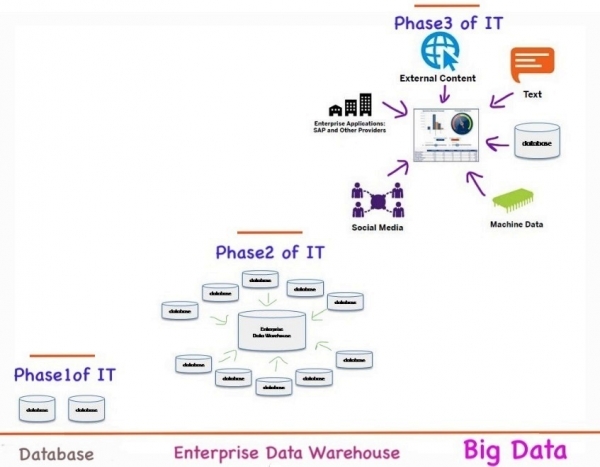


Organizations are using big data technologies to turn large volumes of multi-structured data sets into actionable insights resulting in massive operational efficiencies, increased revenues and new ways of doing things.
Peter Hinssen, a technology entrepreneur and author talks about the evolution of information management within the age of IT. He explains this evolution in three phases of IT.
In the old days, we were too busy figuring out how to manage the information that existed “inside” our organizational boundaries. We built databases, repositories and applications to support our decision making. These applications were built on individual databases resulting in silo sets of information for companies.
The second phase of IT started when we realized that building silo sets of information was not adequate for our decision making. We needed to combine the information from different sources in order to have the enterprise view of information. This was the era of Enterprise Data Warehouse management. Companies began to adopt enterprise BI and performance management tools that would integrate, aggregate and provide an enterprise view of the information that existed “inside” the organizational boundaries.
Today, we are living in the era of Big Data. There are two major observable facts.
First, we care about big sets of information that is constantly evolving. We don’t distinguish between structured and unstructured information anymore. An information contained within a word document can be as important as a field in a database or a tweet.
Secondly, our information boundaries are no longer within the physical boundaries of our organization. We care about the data that exists “inside” as well as “outside” of our organizational boundaries. For every organization, the definition of what’s in and what’s out might be different — but this can change at any time.
Because the information horizon is constantly changing, it is extremely volatile by its very nature. We are entering an era of information management that needs to be much more flexible, agile and scalable. We are living in the age of big data.
The notion of Big data is not new. Big data concept has been around for years. Take a look at utility industry where smart metering technology is processing billions of records and also the financial industry where billions of records are handled through financial trading. There are two major changes that took place over the recent years. First, the technological capabilities have allowed us to discover relationships between large data sets and very broad variety of data. Using these new technologies, Big Data is now a symbol to transform existing business processes, to launch new lines of business, to renovate relationships with customers and to optimize how data is being analyzed. More to the point, the awareness of big data is rising within the marketplace and the technological tools are no longer proprietary to certain industry sectors making it easier for more companies to adopt big data technologies.
With the increasing awareness of big data, companies have begun to make large investments in big data technologies. Unfortunately, having a robust big data technology, managing large sets of data and doing analysis might not solve the business problems. What companies really need is a robust big data technology that can handle large volumes, varieties and volatility of data along with the emotional aspects of human interactions that take place during the data analysis. e.g. how people feel about information privacy, demographics and cultural aspects.
There are three important features of information management that Big Data technologies must support.
Volume– Size isn’t everything when it comes to big data so it’s not just relevant for organizations that are managing large sets of information such as financial and public sector. Big data technologies are just as applicable to companies that manage smaller applications due to complex data processing and analysis supported by Big Data applications.
Velocity– Velocity of data refers to the speed at which information is created and analyzed. The technology needed to manage such information must be lightening fast. Big Data is about managing extreme volatility of data. The key to evaluating the velocity requirements of Big Data is to understand the business processes and requirements of end users.
Variety– Variety is an important trait of big data.The combination of data sources and formats is what matters. Let’s take an example of the utility industry. Companies can use Big Data technologies to combine consumer data with weather forecast and machine data. This integration will result in useful insights that help utility companies analyze energy usage of consumers, predict base load and manage renewable in real time. This results in better demand management and increased profits.
Regardless of the technology selection, your Big Data projects must support real value opportunities and known business needs to create massive operational efficiencies for your users. SAP offers a range of technologies that address Big Data use cases and business requirements.The SAP HANA platform makes possible instant analysis of large amounts of multistructured data and the embedding of analytics into operational applications.SAP HANA integrates structured and unstructured data from internal and external sources, and can work on detailed data without aggregations.
The SAP HANA appliance enables organizations to analyze their business operations using large volumes of detailed operational data in real time while business is happening. Operational data is captured in memory and made available for instant analysis, eliminating the typical lag time between when data is captured in business applications and analysis of that data from reporting and analysis systems.
Sodales Solutions can help you with a successful realization of your Big Data projects. Our team members are certified and highly experienced in HANA enablement.
Curious to learn more? Send me your questions at sana.salam@sodalessolutions.com.